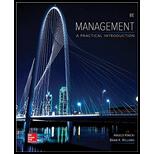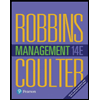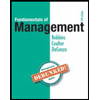
To determine:
The two overarching perspectives about management and three viewpoints under each.
Introduction:
The perspectives about management point out some of the crucial aspects for an organization that should be focused on. These viewpoints are the pathway towards the growth of the organization.
Answer to Problem 1UTC
Solution:
The two overarching perspectives about management are:
Historical perspective and Contemporary perspective
The historical perspective includes three viewpoints - classical, behavioral, and quantitative. The contemporary perspective includes systems, contingency, and quality management.
Explanation of Solution
The classical viewpoint in historical perspective puts focus on ways to manage work effectively and efficiently. The behavioral viewpoint under historical perspective focuses on motivating the employees towards goal by understanding human behavior. The third of the historical perspective suggests making use of quantitative techniques for management.
The system viewpoint in the contemporary perspective defines the organization as a combination of various subsystems that works together to achieve a common goal. The second viewpoint in contemporary perspective is contingency viewpoint which tells that a manager should work as per the situation and condition of an individual. The third is quality management viewpoint which explains that the management of quality is a crucial aspect and should be taken care of.
The organization and manager must consider the overarching perspective about management and all their viewpoints because it ultimately will help them to grow.
Want to see more full solutions like this?
Chapter 2 Solutions
Management: Practical Introduction (Looseleaf) - With Connect
- During the Decision Stage of the Strategy Formulation framework, the focus is upon generating feasible alternative strategies by aligning key external and internal factors. True or False? Question 47Select one: True Falsearrow_forwardWhich of the following is NOT a reason to outsource non-critical activities? Question 49Answer a. Lower costs b. Flatten organization strategy c. Increase competitive responsiveness d. Increase internal bureaucracies Clear my choicearrow_forward_____________ addresses changes within the internal and the external business environment, and can range from strikes to natural disasters, bereavement and other occurrences Question 50Answer a. Strategic Planning b. Contingency Planning c. Disaster Planning d. Organizational Planning Clear my choicearrow_forward
- _____________ is the name given to the firm investing in international operations Question 51Answer a. Host Company b. Global Company c. International Company d. Parent Company Clear my choicearrow_forwardWhich of the following tools are the most appropriate for analyzing the macro-environment? Question 53Answer a. SWOT analysis b. Value Chain Analysis c. Benchmarking d. PESTLE frameworkarrow_forward________________is called the “action stage” of strategic management. Question 48Answer a. Strategy management b. Strategy implementation c. Strategy evaluation d. Strategy formulationarrow_forward
- When evaluating an organization's strategy, it is important to note that corrective actions are almost always needed except when internal and external strategic positions have not changed. The basis of any review would require the redevelopment of a: ____________________________ Question 31Answer a. Value Chain Analysis b. SWOT Analysis c. EFE and IFE Matrix d. PESTLE Analysisarrow_forward___________________refers to the process of redesigning a vertical organisation along its horizontal workflows and processes. Rather than focusing on narrow jobs structured into distinct functional departments, they emphasise core processes that cut horizontally across the organisation and involve teams of employees working together to serve customers Question 23Answer a. Workforce Configuration b. Structural Reengineering c. Business Process Reengineering d. Horizontal Configurationarrow_forwardAlternative plans that can be put into effect during strategic evaluation if certain key events within the strategic plan do not occur as expected. Question 20Answer a. Contingency Plan b. Strategic Evaluation Plan c. None of the provided options d. Emergent Planarrow_forward
- Assuring results is an attainable habit of a strategic leader only if a strategic leader is intentional in developing high performing organisations. Strategic leaders must be intentional in this because they can shape the organisational culture, or the culture may ‘manage’ the leader. One way to do this is to ______________ Question 17Answer a. Develop a Strategic Leadership plan b. Develop a Strategic Implementation Plan c. Implore levers of change d. Develop a Vision Statementarrow_forwardThis stage of the strategic management process, provides a control loop in determining the successful implementation of corporate, competitive, functional and global strategies. It seeks to ascertain the nature of the change betweenplanned strategies and its resultant emergent strategies Question 16Answer a. Strategic Advantage b. Strategic Formulation c. Strategic Implementation d. Strategy Evaluationarrow_forwardHigher product quality than rivals, Superior on-time delivery, A bigger market share, are all examples of: Question 11Answer a. Financial objectives b. Competitive Advantage objectives c. Components of Mission Statement d. Strategic objectivesarrow_forward
 Understanding BusinessManagementISBN:9781259929434Author:William NickelsPublisher:McGraw-Hill Education
Understanding BusinessManagementISBN:9781259929434Author:William NickelsPublisher:McGraw-Hill Education Management (14th Edition)ManagementISBN:9780134527604Author:Stephen P. Robbins, Mary A. CoulterPublisher:PEARSON
Management (14th Edition)ManagementISBN:9780134527604Author:Stephen P. Robbins, Mary A. CoulterPublisher:PEARSON Spreadsheet Modeling & Decision Analysis: A Pract...ManagementISBN:9781305947412Author:Cliff RagsdalePublisher:Cengage Learning
Spreadsheet Modeling & Decision Analysis: A Pract...ManagementISBN:9781305947412Author:Cliff RagsdalePublisher:Cengage Learning Management Information Systems: Managing The Digi...ManagementISBN:9780135191798Author:Kenneth C. Laudon, Jane P. LaudonPublisher:PEARSON
Management Information Systems: Managing The Digi...ManagementISBN:9780135191798Author:Kenneth C. Laudon, Jane P. LaudonPublisher:PEARSON Business Essentials (12th Edition) (What's New in...ManagementISBN:9780134728391Author:Ronald J. Ebert, Ricky W. GriffinPublisher:PEARSON
Business Essentials (12th Edition) (What's New in...ManagementISBN:9780134728391Author:Ronald J. Ebert, Ricky W. GriffinPublisher:PEARSON Fundamentals of Management (10th Edition)ManagementISBN:9780134237473Author:Stephen P. Robbins, Mary A. Coulter, David A. De CenzoPublisher:PEARSON
Fundamentals of Management (10th Edition)ManagementISBN:9780134237473Author:Stephen P. Robbins, Mary A. Coulter, David A. De CenzoPublisher:PEARSON





